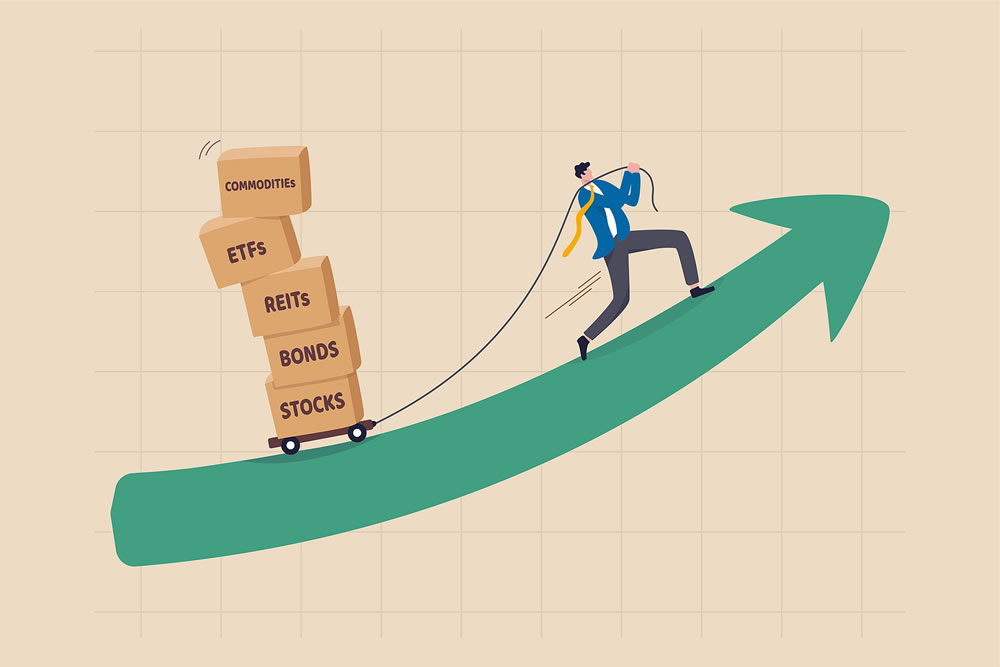Looking to build a robust investment portfolio with a view to creating substantial long-term wealth? Whether you’re new to the concept or a seasoned pro, you’ve no doubt heard of the old adage ‘don’t put all your eggs in one basket’, and it’s an ethos that is definitely worth adhering to in this context.
Investment portfolios are, for many people, designed to serve as nest eggs, which means the last thing you’ll want is for yours to crack. So, to give it the best possible chance of remaining intact and providing you with the healthy compound interest and return on investment you’re hoping for, taking steps to mitigate the level of risk you’re up against by diversifying it as much as possible is key.
But what exactly is a diversified investment portfolio, and how do you go about achieving one? Here, we break it down into some simple steps to get you on the road to success.
What is a diversified portfolio?

Essentially, a diversified portfolio is where capital is spread across various different types of investments, with the intention of enhancing your risk-adjusted returns.
Some people would say that just by owning a managed product, such as an exchange-traded fund or a mutual fund, investors have already gained some form of diversification, and technically speaking, this is true.
These types of funds comprise bundles of bonds, stocks or a mix of both, so they offer a more diversified approach than just owning a single bond or stock – and in turn, owning a bundle of securities through a specific type of fund reduces the ‘per issue’ risk that is present when you own a single security.
That said, when most financial experts refer to portfolio diversification, they actually mean spreading your capital across a range of non-related securities that have behaved independently from one another, so that if one type of asset should see you suffering losses, the others are likely to cushion the blow.
For example, any index fund that tracks within the S&P 500 is, by definition, diversified as it owns several stocks. However, it is nowhere near as diversified as a world-allocation fund that owns bonds and stocks across a number of geographies.
The advantages of a diversified portfolio

The concept of a diversified portfolio is derived from ‘Modern Portfolio Theory‘, which is a particular strategy that was popularised in the early 1950s. It concentrates on investing in a variety of asset classes to lower the overall risk of a portfolio, while trying to make the best returns possible.
Owning a number of holdings that have negative or low correlations with each other allows investors to build a robust portfolio that garners a return that achieves an overall greater level than its individual components, after being risk-adjusted.
How to diversify

Ok, so now that you know what a diversified investment portfolio is, how do you go about creating one? Well, there are a few options available to you.
Foreign stock investment
For some investors, the chance to directly buy into international stocks offers the opportunity to own individual shares within foreign companies.
This strategy has some benefits, as it offers greater control over the investments you accrue and manage, as well as providing you with the opportunity for higher returns – assuming, of course, you choose to invest in promising companies that turn out to be savvy choices.
Whatever you decide to invest in, you should always monitor its performance closely. For example, if you buy into a company like Pilbara Minerals Ltd, regularly check the pls share price; looking at historical data will tell you whether or not it’s a good time to buy, and later down the line, whether selling would be a wise move to preserve your wealth long-term.
Global mutual funds
One of the main types of mutual funds to consider are global mutual funds, which invest in bonds, stocks and securities worldwide. They are typically managed by professional and expert fund managers who have excellent working knowledge and experience within global markets.
A key benefit of diversifying your investments into global mutual funds is that you’ll be spreading your risk across numerous countries and industries, offering an additional means of mitigation and diversification..
ETFs (Exchange-Traded Funds)
Generally referred to as ETFs, Exchange-Traded Funds are investment funds that get bartered on stock exchanges, providing investors with the opportunity to speculate on various assets, including domestic and international markets.
For those who want their diversification strategy to include buying individual stocks from abroad without having to trade in foreign countries, buying international ETFs is a good option.
Tips for diversifying

If you are keen to diversify your investment portfolio, here are three tips to get you started.
Buy an index fund
A quick way to diversify your investment options is to buy stocks in at least 25 different companies.
While you can take the time to research and handpick them individually, you might prefer to purchase an index fund. These pooled investments aim to replicate the returns of market indexes – for instance, the S&P 500, – in a passive way.
They also take much of the guesswork out of investing, which can be particularly handy if you’re new to the game.
Allocate some of your portfolio to fixed-income
Another good way to diversify your investment portfolio is to procure fixed-income assets, such as bonds.
Although doing this will reduce the returns of your overall portfolio, it will simultaneously lower the overall levels of risk and volatility.
Invest in other equities
As an investor, if you really want to diversify, you should also consider other options outside of the stock market, including real estate or gold.
Typically, both offer significant returns over a prolonged period, with little in the way of risk. So, generally, they are seen as representing a safe bet.
You may even consider investing in Bitcoin and other cryptocurrencies, though bearing in mind their volatile nature, doing so does carry significantly greater risk.
The bottom line
At the end of the day, all investments come with risk, and you should only invest what you can afford to lose.
That said, there are several things you can do to minimise the chances of incurring losses and diversifying your portfolio in a way that includes various different equities and securities, and these are some of the easiest ways to do just that.
Disclaimer: Investing money carries risk, do so at your own risk and we advise people to never invest more money than they can afford to lose and to seek professional advice before doing so.






















